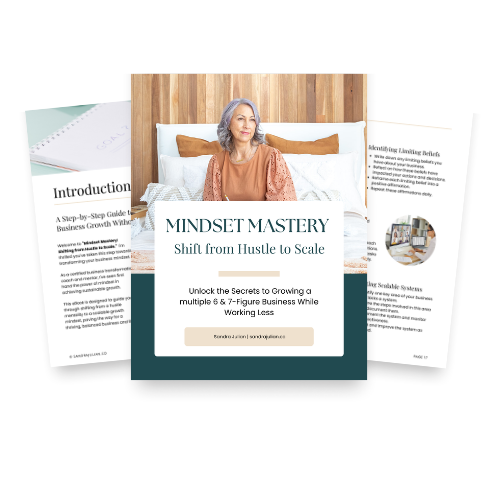💰 Making money while you sleep sounds like the ultimate business dream, right?!
We’ve all heard the success stories: people selling templates, courses, or e-books and supposedly raking in cash while they’re out surfing 🏄♀️, sipping cocktails 🍹, or living their best laptop-free life.
But is it really that simple? 🤔
Not quite.
Megan Elliott (also known as Megan Taylor), who runs a business selling both DIY copy templates ✍️ and fully done-for-you copy packages, knows firsthand that things are a bit more nuanced.
Her business, Copy Template Shop 🛍️, is all about helping her clients craft copy that’s both connection-driven 💬 and deeply strategic 🎯.
And here’s what she has to say about service vs. digital product business models and the myth of passive income.
The Myth of “Passive” Income
The idea that digital products equal easy money is widespread. But here’s the truth: selling templates may be scalable, but it’s far from hands-off.
💡 “Passive income isn’t as passive as the online business world wants us to believe.” – Megan Elliott
Even with automation, running a digital product shop still requires effort:
✅ Customer support: Answering questions and troubleshooting, which was so time consuming, Megan eventually decided to hire help.
✅ Keeping products updated: Content needs refreshing to stay relevant.
✅ Marketing: Driving traffic and sales isn’t automatic. It’s an ongoing job.
That doesn’t mean digital products aren’t worth it! They just require a different kind of effort than a service-based business.
Megan knows the ins and outs of service-based vs digital product-based business models so let’s compare the realities of each.
Service Vs. Digital Products Business: The Pros And Cons In A Nutshell
Both service and digital product business models have their perks and challenges. Here’s how they stack up in Megan’s experience:
Service Business (Copywriting) ✍️
✅ Higher profit margins: Megan’s service-based work is still the money maker. It generates more revenue, plain and simple.
✅ Referral-driven: 98% of her clients come through word-of-mouth, reducing the time and money she needs to dedicate to marketing effort.
✅ Premium pricing: Expertise allows her to charge premium rates.
✅ Relationship-based: Strong client connections lead to retainer clients and a stable income.
Time-intensive: The available hours in a day limit the revenue. As Megan experienced first-hand, burnout can become an issue.
❌ Limited scalability: There’s a cap on how many clients she can take on.
Digital Product Business (Template Shop) 🛍️
✅ Scalable: One product can serve many customers with no extra effort per sale.
✅ Broader reach: Templates attract a different audience than services.
✅ Lower barrier to entry: More affordable for customers who can’t afford your done-for -you services.
❌ Requires consistent marketing: Unlike services, sales don’t just happen. You need to promote tirelessly (and figure out the best way to reach your audience).
❌ Not as passive as it seems: Customer service, product updates, and launches take time.
❌ Volume-dependent: Needs (a lot!) more sales to match the revenue of a single service client.
Megan’s Tips For Business Owners Considering Selling Digital Products Online
If you’re thinking about selling digital products online, here’s what Megan thinks you should keep in mind:
✔ Start small: Test demand before investing too much time or money.
✔ Expect to spend time setting up and on updating existing products : Just like with services, the work is never done, although it may be less time sensitive.
✔ Know your numbers: Figure out how many sales you need to make it your worth’s while. Set the goalpost in advance. If it doesn’t work out, change your approach.
✔ Expect marketing work: Unlike services where word of mouth can do all the heavy lifting, templates won’t sell themselves.
✔ One doesn’t exclude the other: Business isn’t always a case of one or the other. Sometimes it’s a combination of both business models that works for you.
✔ Challenge the “ladder” myth: Not all template buyers will become service clients. In Megan’s experience, it’s rarely the case.
Combining The Service And Digital Product Business Model: Embracing The Ebb & Flow
For Megan, it’s a combination of a service and digital product business model that works best. But if you’re imagining perfect balance, that’s not the case either.
💡 “The balance is very much a fluctuating balance… It’s not a scale where everything is even… It happens for me in seasons.” – Megan Elliott
It’s about knowing when to focus on each. Some seasons are for client work, others for product creation, and sometimes, life demands a pause.
By embracing this ebb and flow, Megan has been able to:
✅ Prioritise high-revenue service work when her retainer clients need extra attention.
✅ Invest time in growing her product shop during slower client seasons.
✅ Step back when personal life or business requires a shift.
So, if you’re juggling both (or considering it), don’t stress about balancing it all at once. Instead, go with the flow and adjust as needed.
Want Some Help With That?
Wow, what a chat!
I hope you all walked away with pages of notes (and maybe a few lightbulb moments 💡) from my conversation with Megan Elliott. Whether you’re sticking with services, dipping your toes into digital products, or building a hybrid model, there’s no one-size-fits-all. Just building the business that works best for you!
Got questions about launching your own product shop? Drop them in the comments. I’d love to hear your thoughts! 💬
And if you need expert guidance on crafting high-converting copy (without spending hours staring at a blinking cursor), Megan’s your go-to. Check out The Copy Template Shop for DIY copy resources or reach out for her done-for-you services.
📩 Email: megan@megantaylor.co
📱 Instagram: @copytemplateshop
🧵 Threads: @megantaylor.co
Until next time. Keep building a business your way!




